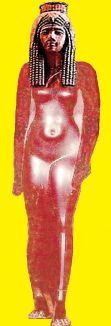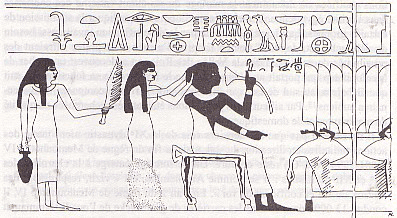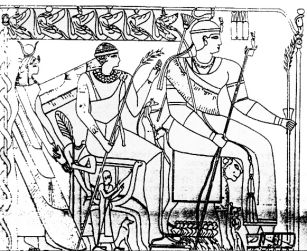When from the top of his throne with lion's feet, the pharaoh saw this princess of twelve years, coming forward stepping lightly and proudly, the one whose name inspired an awe from Philae to Heliopolis, the one that no human being had seen the face of bronze without quivering, felt a strange confusion into his heart.
She wore a complicated crown simulating a vulture. On her muscular and slender legs glittered circles of agate and carnelian; on her wrists, hematite bracelets, enamel, lapis lazuli, on her fingers, rings throwing so many lights that they could not be counted, and several heavy gold necklaces hung from her neck until her thin round belly brighting as the moon. "*
The Kushite wife of Kamose
The lady Maket buried in El Lahun
aka Makeda princess of Saba-Meroe
"Miriam and Aaron began to talk against Moses because of his Cushite wife ;
for he had married a Cushite woman" (Numbers, 1: 12)
The oldest of these tombs contained the mummy of a woman named Maket. She had near her several gold rings with her name differently written with the title "the lady of the house".
Her coffin had the distinction of being together with baskets of woven fibers of Nubian type. The dating of this family tomb is still controversial, but considering the city was still occupied at the beginning of the 18th dynasty, it is not impossible that Maket, the first owner of the tomb, lived around 1550 B.C.
Moreover, we note that the name of Maket recalls the name of the Queen of Sheba known as Makeda in the Ethiopian tradition.
This brings us to consider the great tomb known as the "Maket's tomb" in the pyramid city of Sesostris II at the entrance of the Fayum. The great English archaeologist Sir Flinders Petrie first excavated the monumental city of "Hotep Senusert" in El Lahun. There, carved from a cellar of a large house in the east part of the city, he discovered a family tomb that housed twelve coffins containing the bodies of 40 to 50 individuals.
* From the novel "MAKEDA Queen of Sheba" by Prince Yacoub, former advisor to the Empire of Ethiopia." Translated from Ethiopian language by Gabriel Aubarede. http://www.volcreole.com/forum/sujet-30059.html (in French).
The Bible (Numbers 12, 1) states that Moses had married a Kushite woman without any other details relating thereto, whereas Flavius Josephus points out in his "Antiquity of the Jews" (II, 10) that Moses married the daughter of the king of the city of Meroe formerly known as Saba. Eusebius of Caesarea, in turn, (Praeparatio Evangelica, IX: 27) called Merris the adoptive mother of Moses that a danger at the time did not allow him to go and bury in Nubia. She would then be buried in Egypt in a place which was later called Meroe in memory of the country of birth of the deceased. There will be probably a confusion with the wife of Moses, as it would be not clear why the mother of Moses who was a queen of Egypt should have her burial in Nubia.

But the name Merris reminds us the Moeris Lake (now Lake Karun) west of the oasis of Fayum. This name known as far as the Greek period could be due to the proximity of the tomb of a princess born in Meroe. You can also notice that both names have almost the same significance in Egyptian language : Moeris = "mer our" the big lake and Fayum = "pa-yum" the sea (Indeed Lake Karun was far more extensive in ancient times than today ).



"I want a city to be built here, she said. It will be named Sheba, and I want that there will be no more beautiful one in the world. I want that in the center there will be three palaces as an arc, each of which may contain fifty thousand people, and I want at the center of this triple girth, a fourth palace standing up to the clouds, which will be my home. I want to see everywhere gardens full of various plant species and rare animals. I want that in these gardens, scented rivers flow and spread out as lakes with islands of flowers, and gush jets of colored water."*
We can imagine such circumstances for the meeting of the young and impetuous prince Kamose and Meket the pretty little Nubian princess of Meroe who will become later the mother of the great queen Ahmose-Nefertari. And perhaps it is at the request of the first wife of Kamose that the city of Meroe, formerly named Saba according to Flavius Josephus ("Antiquity of the Jews" II, 10) was built.